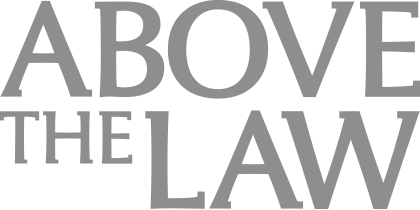Profiles In Innovation: An Interview With Owen Byrd Of Lex Machina
Checking in with a leading voice in legal technology, on the occasion of a major new product launch.

Owen Byrd
Over the course of preparing for yesterday’s webcast on legal analytics and commercial litigation, hosted by Above the Law and sponsored by Lex Machina, I had the pleasure of getting to know Owen Byrd, the company’s chief evangelist and general counsel. I was so intrigued by his story — both his own career trajectory, and the origins and growth of Lex Machina — that I caught up with him by phone later in the day for more detailed discussion.
(In case you missed the webcast but would like to listen to it — we’re good company for commuting, or working out at the gym — you can access it here. Just fill in the registration information, or click on the “already registered” button if you previously signed up.)

Happy Lawyers, Better Results The Key To Thriving In Tough Times
Owen Byrd is no stranger to our pages. He’s a prominent figure and thought leader in legal, technology, and entrepreneurship circles, and we have interviewed him and cited his work in the past. But I thought that now would be an opportune time to visit with him again, in light of Lex Machina’s launch yesterday of Legal Analytics for Commercial Litigation.
Here’s a (lightly edited and condensed) write-up of our conversation.
DL: As my colleague Zach Abramowitz noted in an earlier interview, you have an enviable résumé, including a law degree from the University of Chicago and time spent at Cooley, a top Silicon Valley law firm. But you turned down Biglaw in favor of something different. Can you tell us a bit about your career path?
OB: When I got out of law school, I spent the first chunk of my career doing public interest environmental work. The University of Chicago takes a particularly quantitative approach to law. While I quickly discovered I was ideologically out of sync with the law school’s political identity — I’m pretty far left for Chicago — its quantitative focus really resonated with me. I’m a “data geek.” When I started doing public interest work in the environmental space, including supervising litigation and working on issue campaigns, I brought that Chicago data-geek mindset to bear on everything I did.
Sponsored


Law Firm Business Development Is More Than Relationship Building

Curbing Client And Talent Loss With Productivity Tech

Law Firm Business Development Is More Than Relationship Building
Eventually I made my way to Silicon Valley. I practiced law and launched companies, but always with a heavy data component, living at the intersection of law, technology, and data.
DL: Which seems like a perfect background for Lex Machina….
OB: Look at Moneyball, and the application of analytics to fields as diverse as sports, finance, and marketing. Everything has become analytics-driven. Why not law? That’s what Lex Machina is all about.
In 2010, Lex Machina — which started out as a public interest project at Stanford Law School, focused on quantitative analysis of patent litigation — spun out as a private company. In 2011, the board hired my friend Josh Becker as CEO.
Josh called me up and asked, “What are you up to?” I said, “Oh, this and that.” He said, “I just got hired at a legal startup that’s all about law, technology, and data. You’re the only person I know who’s both a lawyer and a data geek. Will you join us?”
Sponsored

Happy Lawyers, Better Results The Key To Thriving In Tough Times

Generative AI at Work: Boosting e-Discovery Efficiency for Corporate Legal Teams
Josh and I were the fifth and sixth people to join the company. We were a small, scrappy Silicon Valley startup. I was our first sales, marketing, and customer-success employee. What did I know about selling legal tech? But I went out and started talking to lawyers and communicating my sincere and authentic excitement about applying legal analytics to the practice of law.
Things went well, and the company grew. Today we have more than half of the Am Law 100 firms as subscribers, as well as lots of midsize firms and boutiques.
DL: And now you have around 100 employees. How has your role at Lex Machina evolved?
OB: As we grew, the cavalry arrived. We hired Karl Harris as our Chief Technology Officer, and Joerg Rathenberg as our vice president of marketing. We hired our first VP of sales. This allowed me to transition into my current role as chief evangelist, where I get to be a thought leader. I speak, write, blog, and webcast, carrying the good word about legal technology and Lex Machina.
DL: I love the title of “evangelist.” I’ve noticed other folks with that title too — such as Niki Black of MyCase, one of our tech columnists here at Above the Law.
OB: The title originated with Guy Kawasaki, who was Apple’s chief evangelist under Steve Jobs, and who defined the role. I periodically do a search for “evangelist” on LinkedIn — it has gone mainstream with the tech industry, and it’s starting to appear in org charts beyond tech as well.
DL: And you also wear the hat of general counsel.
OB: Yes — I really still am a lawyer. In general I spend about 70 percent of my time on evangelism, but that rises and falls depending on what’s going on. For example, leading up to our acquisition by Lexis, I spent months as a member of the legal team, working on an M&A deal.
DL: Speaking of that acquisition, which took place in 2015, how have you found being part of the LexisNexis empire?
OB: It’s been great. We get the best of both worlds: the resources of the mother ship, and the nimbleness of a scrappy, Silicon Valley tech company.
Lexis acquired us for two reasons. First, we’ve got a great technology with great growth prospects, and Lexis wants to be a leader in legal analytics. Second, Lexis has a sincere desire to become Valley-like, to develop products in lean, iterative ways. So they acquired us not just because they believe in our tech and our team, but to see how we do things as a startup, and to incorporate some of our Valley-style approaches into the larger organization.
It can be a challenge for a big incumbent to remain agile. To its credit, Lexis has a sincere desire to stay light on its feet.
We enjoy a great deal of independence at Lex Machina. This is Lexis’s general approach to acquisitions, ranging from Ravel Law to Intelligize to Law360.
DL: Let’s fast forward to this week and to the launch of Legal Analytics for Commercial Litigation. For readers who missed the webcast, tell us what the new product is all about, in a nutshell.
Our beachhead at Lex Machina was intellectual property law, where we proved the immense value of legal analytics. This week, with the launch of Legal Analytics for Commercial Litigation, we make good on our commitment to bring analytics to the rest of the law.
This is why we’re moving first into commercial litigation, the biggest chunk of civil litigation. And while we will be adding analytics for other subjects, we thought, let’s go big quickly. If we truly believe we can bring analytics to what I’d call the “broad middle” of the law, then let’s do it.
DL: What special challenges did commercial litigation present as a subject matter?
OB: We faced a good, hard problem to solve in terms of the absence of a “commercial” tag in PACER [Public Access to Court Electronic Records — the repository for federal litigation dockets and documents]. For patent litigation, you can more or less capture all the cases with a patent litigation code (and our technology also captures IP cases that get mis-coded). But grokking commercial analytics is hard because there’s no code for it in the dockets.
We had to go out and talk to practitioners. Which cases do you consider “commercial” and would want analytics about? What emerged from these talks was that core commercial cases have a breach of contract claim, a business tort claim, or both.
Then we thought, how do we extract those cases sprinkled across multiple codes? We solved this problem with natural language processing, machine learning, and expert attorney coders. We now have a system that captures every federal case with a breach of contract claim, a business tort claim, or both.
This lets us give commercial litigators incredible insights about those cases — for example, how often a certain judge decides contract breach cases, how she tends to resolve them, how long such cases typically take from filing to resolution, and which law firms and lawyers have appeared — and prevailed — most frequently before that judge.
DL: Given the vast amount of data and the trickiness of organizing it, how long was the commercial lit product under development?
OB: This is a true Silicon Valley story. Josh Becker and I arrived at Lex Machina in 2011. In 2012, we hired Karl Harris as our CTO and VP of product. Karl was straight out of central casting for this role: he had an advanced degree in computer science; he was on the founding team of an analytics firm called Flurry, which got acquired by Yahoo; he graduated from Stanford Law School, and worked on patent litigation while in school; and at the time that we connected with him, he was working for a VC firm that was one of our investors. We met him and thought, you’re perfect for this role.
Karl took one look at the legacy public-interest platform we had inherited from Stanford and told me and Josh, “Guys, you won’t want to hear this, but the way this platform is designed, it’s not scalable — we have to rebuild the whole thing.”
Josh just about had a stroke. We were a leanly funded, early-stage startup — and now we have to throw scarce engineering resources into building our platform from the ground up?
But Josh and the board, after careful consideration, swallowed hard and agreed. Karl and his team spent a year rebuilding the platform. We relaunched in 2013, with a much better, easier-to-use product.
Karl’s real genius was in designing a platform for today. He built something that could take documents and dockets from many different practice areas and still work well.
So that gamble that Josh and the board took on Karl’s advice back in 2012, it just paid off today. It’s hard to say how emotional for us this is. I’ve been here for almost six years, basically waiting for this day. In some ways, it’s a bigger day for us than when we were acquired.
DL: Why would you say today is so momentous for you?
For us, Lex Machina has always been about the vision of bringing greater openness and transparency to law, going all the way back to the company’s origins as a public-interest project. Now we are a business, and sure, we want to make money, but we’re here to do good and to do well. We believe deeply in the power of analytics to improve the law.
As important as our existing practice areas are — and they are very important, involving disputes that are critical to the U.S. legal system and economy — they are still somewhat narrow. Commercial law is, as I’ve said before, the “broad middle” of the law. If analytics can deliver value here, then we have fulfilled our vision. And that is a deeply meaningful achievement.
DL: So Legal Analytics for Commercial Litigation was built on the platform that Karl Harris designed and that you relaunched in 2013. How much additional time did it take to develop the commercial litigation piece?
OB: This actually ties into our Lexis deal. One of our biggest expenses over the years has been PACER fees, paying the federal government to get the raw material, the dockets and documents, that we need for analytics. Back in 2015, we started thinking about all the money spent on PACER, wondering if there might be a cheaper way to get these cases. We started talking to a number of big incumbents who had already bought this PACER data, seeing if maybe we could buy it from them. One of the companies we talked to was Lexis, and the “letting you buy our data” conversation evolved into a “letting us buy you” deal.
We were acquired by LexisNexis in November 2015. After that, it took months for our tech team to work with the Lexis team to get access to the PACER data. Once we got access, we had to simultaneously talk to practitioners about their thoughts on what’s a “commercial” case, train the machine to make sense of those cases, bring aboard expert attorney coders for quality checking and manual coding of any mis-coded cases, and code up more than 60,000 cases. It took us about a year.
DL: Now that you’ve developed this platform and acquired the data, it seems that expanding into new practice areas should be much easier. What are your future plans?
OB: We’re looking at employment, bankruptcy, and products-liability litigation, as well as additional areas. As for timing, nobody in Silicon Valley likes to commit to a release date — look at how Apple handles its product launches — but I can say that we are now in a position to roll out new practice areas on a very regular basis, over the rest of this year and beyond.
DL: And this is just federal litigation we’re talking about….
OB: Yes, because that’s what we have the data for, through PACER. But legal analytics can have huge value for state litigation as well. And our overall vision is not just federal law, but all subjects in the law.
Later on this year or sometime next year, we want to take a run at our first state. Over a multi-year time horizon, we want to expand to cover all federal and state litigation.
This mission will keep us in business for a very long time. I look forward to chatting with you someday a few years from now, when we’ll be talking about releasing legal analytics for our final state.
DL: What about legal analytics for other countries?
OB: Absolutely. We get asked that all the time — when will you have analytics for Canada, or Brazil, or Japan? The sky’s the limit.
DL: Indeed — and we look forward to seeing where the future takes you. For now, congratulations to you and Lex Machina on the launch of Legal Analytics for Commercial Litigation, and on all of your success to date!
Lex Machina Expands its Award-Winning Legal Analytics Platform to Commercial Litigation [Lex Machina (press release)]
New Legal Analytics for Commercial Litigation / The Winning Edge for Lawyers [webcast]
Earlier:
 David Lat is the founder and managing editor of Above the Law and the author of Supreme Ambitions: A Novel. He previously worked as a federal prosecutor in Newark, New Jersey; a litigation associate at Wachtell, Lipton, Rosen & Katz; and a law clerk to Judge Diarmuid F. O’Scannlain of the U.S. Court of Appeals for the Ninth Circuit. You can connect with David on Twitter (@DavidLat), LinkedIn, and Facebook, and you can reach him by email at [email protected].
David Lat is the founder and managing editor of Above the Law and the author of Supreme Ambitions: A Novel. He previously worked as a federal prosecutor in Newark, New Jersey; a litigation associate at Wachtell, Lipton, Rosen & Katz; and a law clerk to Judge Diarmuid F. O’Scannlain of the U.S. Court of Appeals for the Ninth Circuit. You can connect with David on Twitter (@DavidLat), LinkedIn, and Facebook, and you can reach him by email at [email protected].







